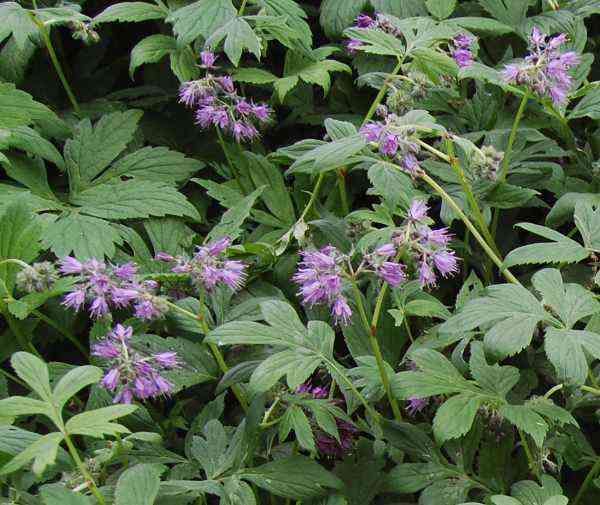Your cart is currently empty!
Gardening for Birds: Planting for Woodpeckers
Learn how to attract woodpeckers to your garden with native plants that provide food and habitat, based on expert advice.
Your cart is currently empty!
Photo:
H. Zell, CC BY-SA 3.0, via Wikimedia Commons
Virginia waterleaf, Hydrophyllum virginianum, is an excellent choice for shady areas and woodland gardens. It can spread quickly from rhizomes and fill open areas, where some gardeners use it as a groundcover.
Virginia waterleaf is a perennial typically found in low woods, thickets, ravine bottoms, bluff bases, river flood plains and stream valleys. It is a perennial native to moist and wet woods in northwestern North America, ranging from Quebec to Manitoba in Canada and south to North Carolina and Tennessee.
Botanical Name: Hydrophyllum virginianum
Also Called: Eastern Waterleaf
En français: Hydrophylle de Virginie
Blooms:
Sun / Shade:
Water: medium to moist
Height:
Pollinators:
Recognize it by five (5) long narrow sepals with feathery edges under the flower head. One plant has 1 or 2 clusters on a stem, and may have multiple stems. It will bloom in white or violet colours, from May to June. Seeds occur in July and/or August. Virginia waterleaf presumably gets its name from the water-like spots on its leaves.

Bumble bees, carpenter bees, and other bee species enjoy it as well.
It is best grown in consistently moist, well-drained soils in a light shady spot. They can grow aggressively in optimum conditions.
Hydrophyllum virginianum is recommended for covering bare spots and to help stop soil erosion. It is also good for planting where buckthrorn has been removed. It can be planted in the spring or early fall. For best results of seed propagation, sow outdoors immediately after collection. It is not recommended for small gardens as it spreads aggressively.
Flowers are followed by seed capsules. When ripe the capsules split open to release the small seeds. It self-seeds readily and division is the best method to propagate. The best time to divide these plants is in the fall, after it has gone dormant. Ensure there are buds and some roots on each split portion.
To make a great woodland garden, combine Virginia Waterleaf with Polemonium reptans (Jacob’s ladder), Phacelia bipinnatifida (Fernleaf Phacelai), Erythronium americanum (Trout lily), Podophyllum peltatum (Mayapple), Dryopteris intermedia (Wood Fern), and/or Caulophyllum thalictroides (Blue Cohosh). It grows well around sugar maples, white ash, American beech, and yellow birch.
Virginia waterleaf is edible. Use its young leaves in baked dishes and smoothies, or in salads and on sandwiches. Roots can be used to make tea. It is an astringent, used in treatment of mild diarrhea. Indigenous peoples ate the young plants and leaves after cooking.
It has few pests, but sometimes deer may browse the foliage.
Learn how to attract woodpeckers to your garden with native plants that provide food and habitat, based on expert advice.
Salvia is a blooming, decorative garden plant with nectar-rich blooms that attract a variety bees, butterflies, and hummingbirds.
Backyard gardening is good for physical health and well-being, and it’s an enjoyable hobby that can help you to connect with the natural world around you.
Daylilies companion well with lythrum, delphinium, gilia, or other tall plants. And they are at their best planted near evergreens or holly.
I will be reviewing my sketches and notes, making changes planning my garden layout and building up my annual wish list of seeds.
Learn sustainable mushroom cultivation. Along with their sustainability, numerous types of mushrooms are a nutritious food with decreased calories and no cholesterol or fat. Use these eco-friendly tips and start growing mushrooms today!
GardeningCalendar.ca gets some funding from advertisers. If you click on links and advertisements at no cost to you, the site may receive a small commission that helps fund its operation.
© 2025 J&S Calendars Ltd.
Leave a Reply
You must be logged in to post a comment.